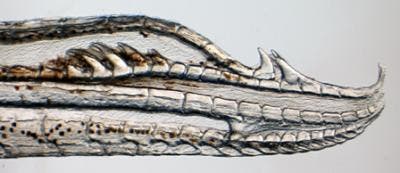Biologists have found a new species of fresh water fish east-central Mexican waters, and what they discovered was more than they bargained for. Apparently, to fight off the female’s selective reproduction blocking mechanism, the male has evolved an… interesting, let’s say, penetration mechanism of its self – a four hook genitalia. No, this is not a medieval weapon.


Females of the llanos mosquitofish, or Gambusia quadruncus, have developed a defense mechanism against overly zealous males who don’t know to take no for an answer by essentially growing a ball-shaped tissue blocking most of the genital pore – restricting entry of the male’s gonopodial tip. Besides this, the females also exhibit a colorful anal spot, which scientists aren’t yet sure if it’s used to signal the location of the gonopore to the male or flag fish of their own species from fish of other species to reduce costly cross-breeding (hybridization is always costly and genetically bad). Tricks like this never come alone, and evolution isn’t forgiving, and how spiteful it was for the female G. quadruncus.
“Having four hooks on the gonopodium may provide a means of overcoming female resistance, latching on to the gonopore and transferring sperm in a manner that facilitates effective sperm transfer. Or it may serve to stimulate the female in a manner that causes responses in the female that facilitate effective sperm transfer,” says Dr. Brian Langerhans, assistant professor of biology at NC State and the lead author of the paper.
If the latter of what Langerhans is true, than these fish are one kinky pair.
Findings were reported in the Journal of Fish Biology.






